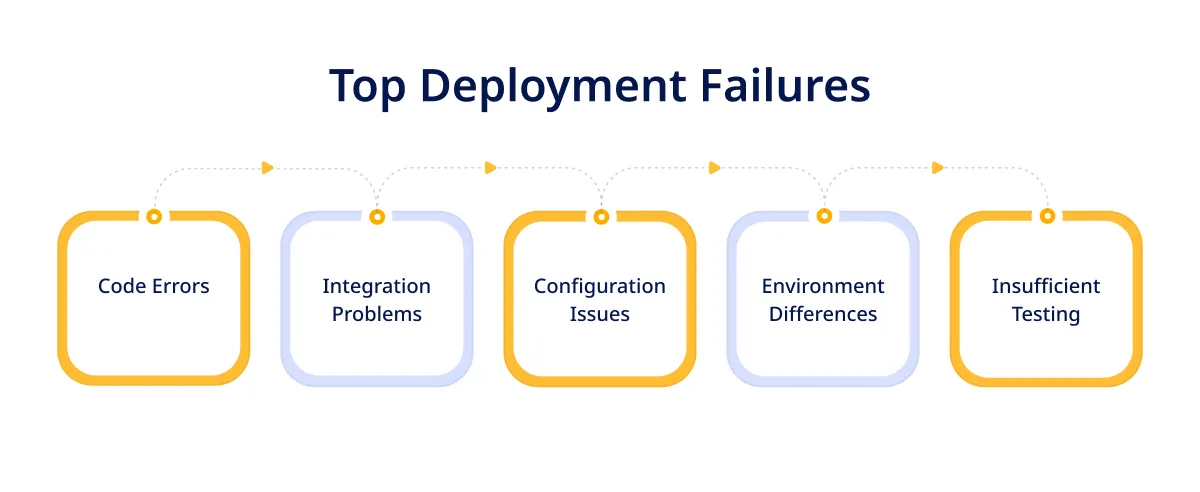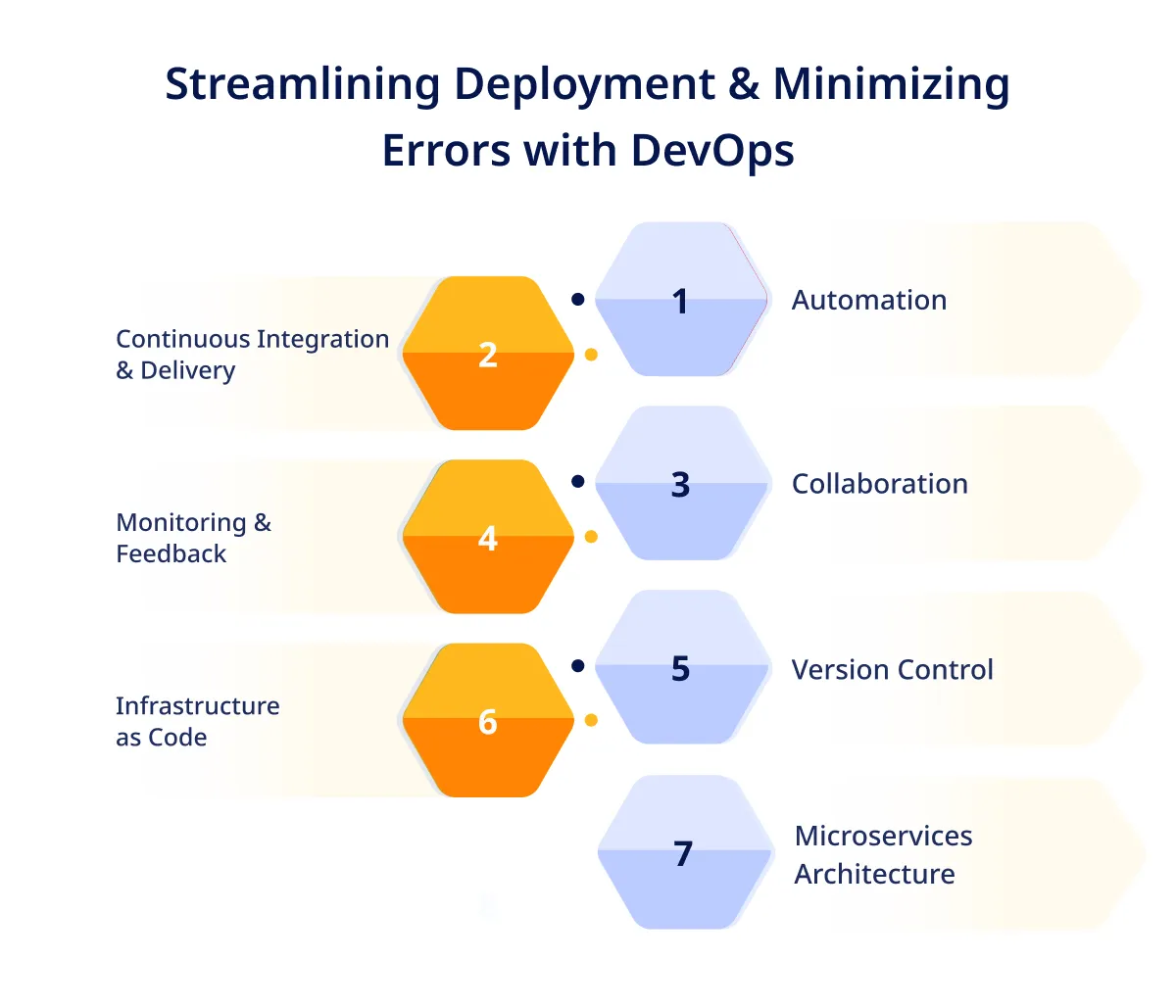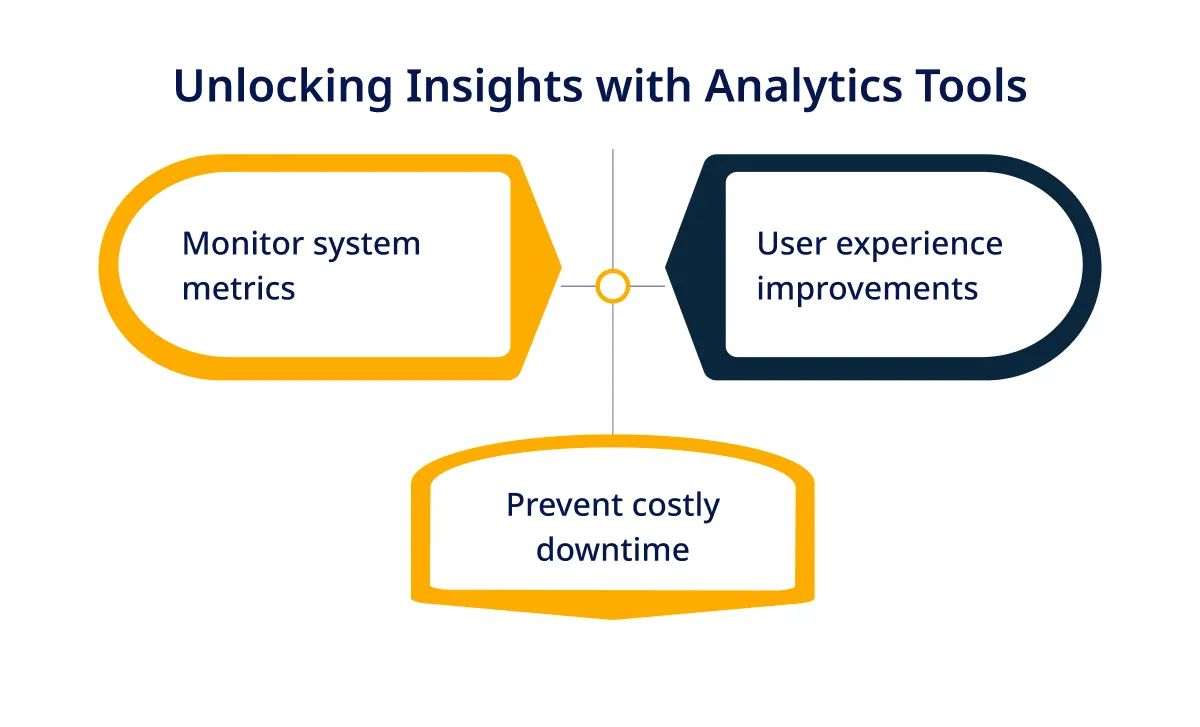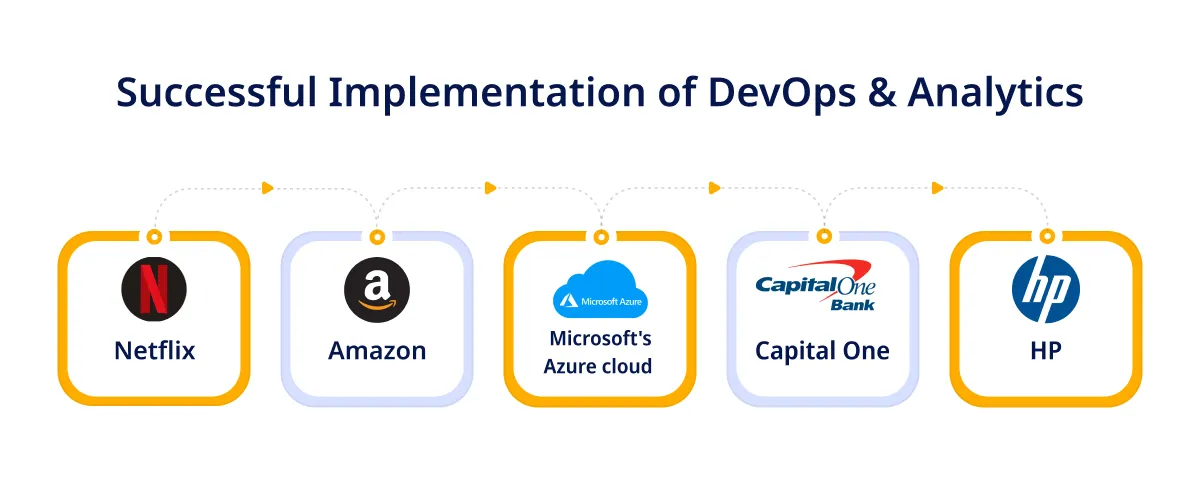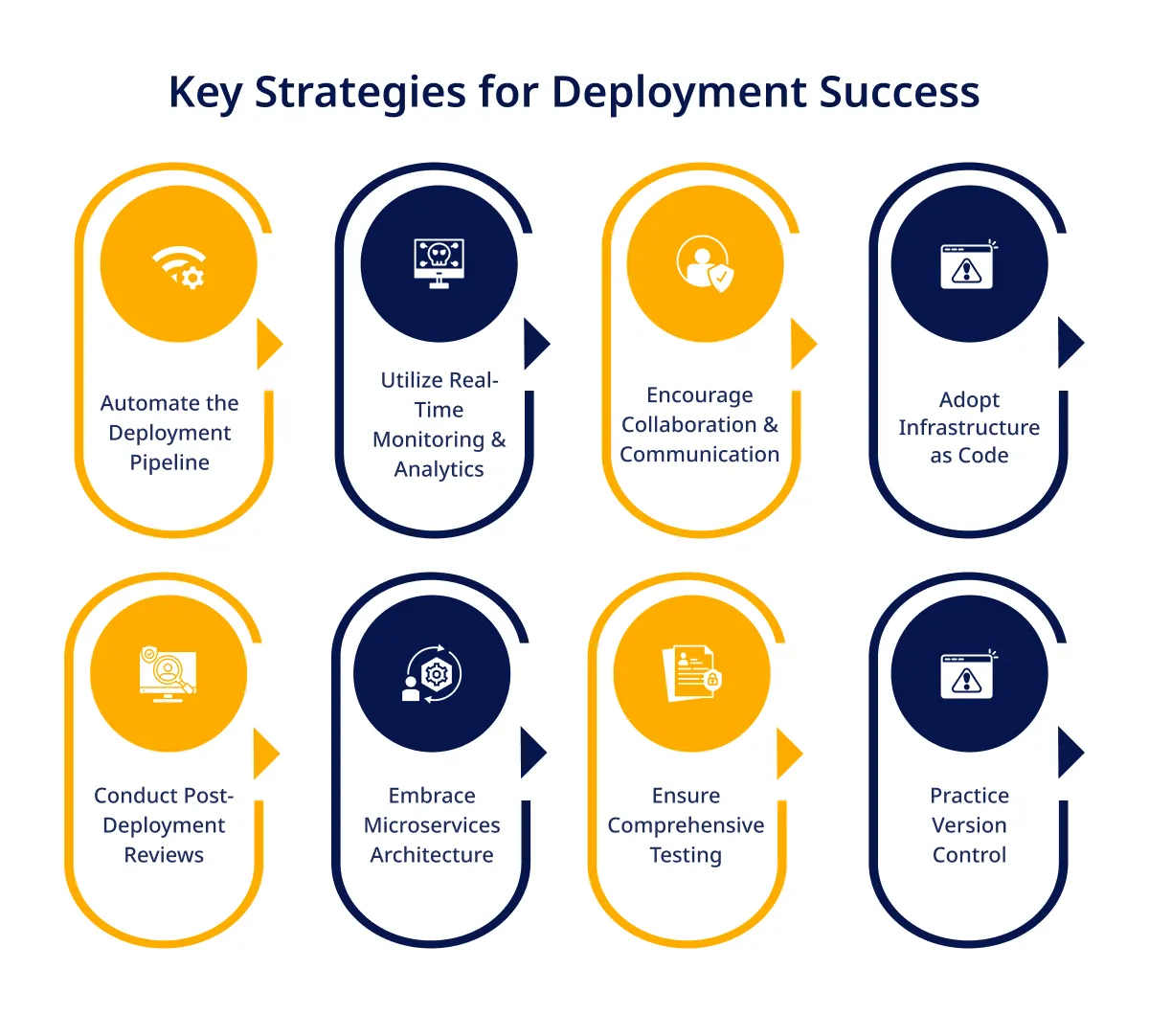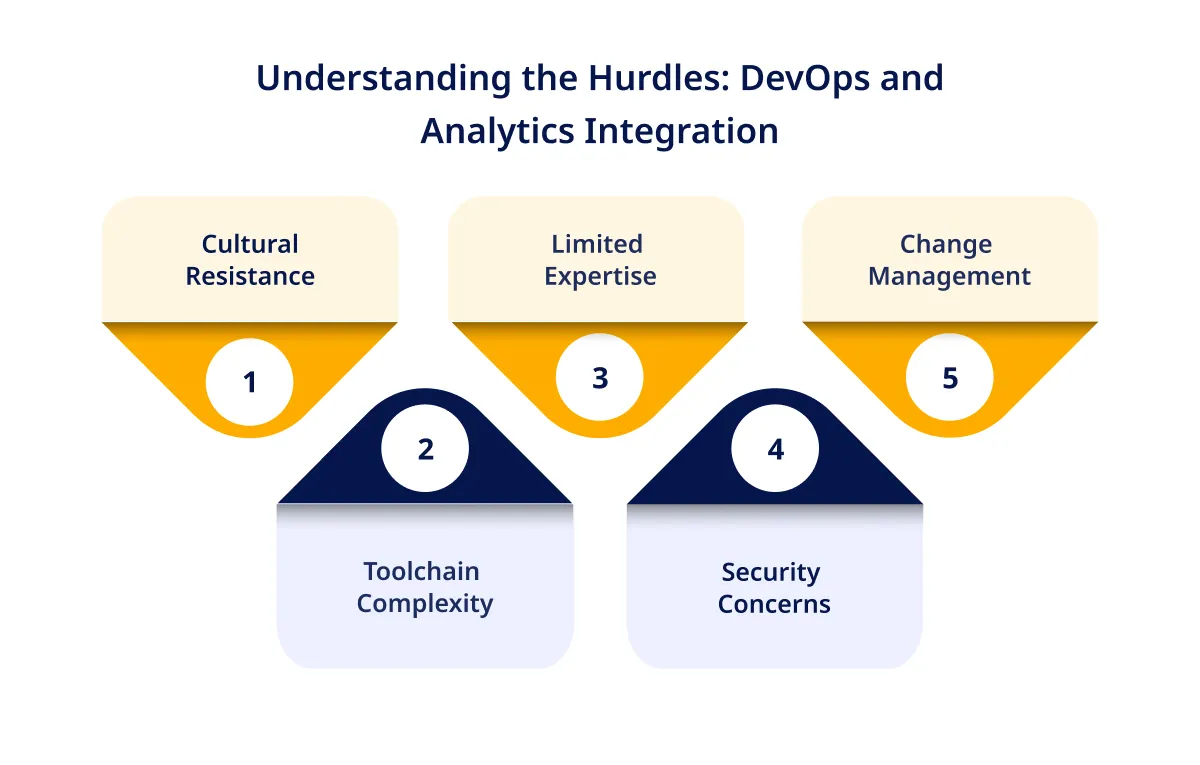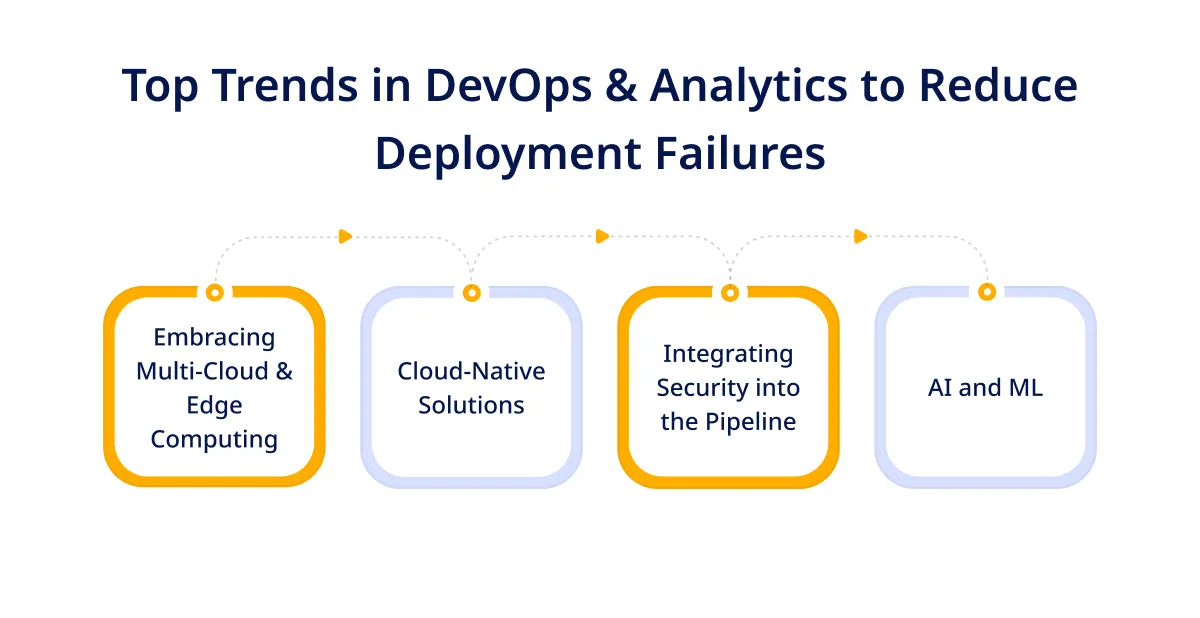Are you struggling to run your software business smoothly?
If yes, this blog post can offer valuable insights & strategies to help you overcome the challenges and optimize efficiency.
Smooth software deployment is more than a technical necessity for modern businesses in today’s fast-paced, hyper-connected world. Deployment failures disrupt operations, inflict severe financial losses, and damage a company’s reputation.
By leveraging advanced analytics & robust DevOps monitoring, organizations can
- Reduce the risk of costly downtime
- Enhance operational efficiency
- Deliver a seamless user experience
This blog post emphasizes on the cutting-edge strategies that keep your systems running flawlessly and safeguarding your business against the high stakes of deployment failures.
Understanding Deployment Failures
Deployment failures usually occur when software fails to launch correctly into a production environment. This leads to system outages, performance degradation, or security vulnerabilities.
These failures will cause some significant impacts, including
- Financial losses from downtime
- Damage to the company’s reputation
- Loss of customer trust
Common causes of deployment failures include:
Here is the list of some common causes of deployment failures:
- Code Errors: Bugs & defects in the code usually cause unexpected behavior in the software production environment.
- Integration Problems: Issues often arise when new code needs to integrate smoothly with existing systems or third-party services.
- Configuration Issues: Incorrect or inconsistent configuration settings can lead to system malfunctions.
- Environment Differences: Discrepancies between development, testing, and production environments can cause deployments to fail.
- Insufficient Testing: Inadequate testing can allow critical issues to slip through, leading to failures in the live environment.
Trust us to streamline your deployment process and enhance reliability.
Importance of Proactive Identification & Addressing of Issues
Identifying & addressing the above issues proactively is crucial for businesses. Let’s understand its importance as discussed below:
- Implementing robust DevOps monitoring practices and leveraging analytics helps detect potential problems early.
- Proactive measures streamline the deployment process and ensure a smoother transition to production.
- This approach mitigates the risk of deployment failures, thus, enhancing overall system reliability and performance.
An Overview of the Role of DevOps
DevOps technology is the set of safe practices emphasizing collaboration, automation, and continuous improvement between software development and operations teams. Its principles are designed to
- Break down silos
- Streamline workflows
- Enhance the quality & speed of software delivery
Continuous DevOps monitoring can help you streamline software deployment and reduce such errors. Let’s understand this as discussed below:
1. Collaboration: DevOps in the business process fosters a culture of collaboration where software developers and the operations teams work together throughout the complete software development lifecycle. This close cooperation ensures that all parties are aligned on goals and processes. This reduces miscommunication & errors.
2. Automation: Automation is central to DevOps monitoring. It helps to eliminate repetitive tasks and reduce the risk of human error. Automated testing, deployment, and monitoring ensure that software can be delivered rapidly and reliably.
3. Continuous Integration & Continuous Delivery: CI/CD practices involve integrating code changes frequently and deploying them automatically. This approach allows for faster issue detection and resolution and ensures that code is always in a deployable state.
4. Monitoring & Feedback: Continuous DevOps monitoring and feedback loops are critical. By constantly observing system performance and gathering user feedback, teams can quickly identify and address issues, improving overall system reliability.
5. Version Control: Version control systems track code changes, making it easier to manage and roll back updates if necessary. This ensures consistency in deployments and the quick restoration of previous versions in case of failure.
6. Infrastructure as Code: IaC involves managing & provisioning computing infrastructure through code rather than manual processes. This practice enables more consistent and reliable deployments, as infrastructure configurations are versioned and tested like application code.
7. Microservices Architecture: Microservices break down applications into smaller, independent services that can be developed and deployed separately. This architecture allows for more flexibility and reduces the impact of changes or failures in any single component.
By adopting these DevOps analytics monitoring principles and practices, organizations can streamline their deployment processes, minimize errors, and achieve more reliable and efficient software delivery. This further reduces costly downtime and enhances business performance.
Also read: DevOps As A Service: Revolutionizing Software Deployment
Leveraging Analytics for Deployment Optimization
Organizations can monitor various metrics and comprehensively understand their software environment by integrating various analytics tools. Analytics in software development & deployment involves using data-driven insights to
- Enhance system performance
- Improve user experience
- Anticipate potential issues
Unlocking Insights with Analytics Tools
Here, you will gain some effective DevOps insights using analytics tools:
- Monitor System Metrics: Analytics tools track key performance indicators such as server load, response times, and error rates. This provides real-time visibility into system health.
- User Experience Improvements: Analyzing user behavior and feedback helps identify pain points & optimize the user experience. This further leads to higher satisfaction & retention rates.
- Prevent Costly Downtime: By detecting anomalies & performance degradation early, analytics tools allow teams to address such issues before they further escalate into major problems. This minimizes downtime and its associated costs.
Leverage our expertise in DevOps and analytics to prevent costly disruptions.
Predictive Analytics: Anticipating Deployment Failures
Predictive analytics uses historical data & machine learning algorithms to convey potential deployment issues. By identifying patterns and trends that precede failures, these tools can alert teams to
- Take preventive measures
- Ensure smoother deployments
- Reduce the risk of downtime
Incorporating analytics into the deployment process empowers organizations to make informed decisions, proactively address issues, and optimize performance. This ultimately leads to more reliable and efficient software delivery.
Must Read: Role Of Machine Learning In Predictive Analytics
Some Popular Success Stories
Here is a list of some real-world examples that illustrate how organizations can effectively reduce deployment failures through the implementation of DevOps monitoring practices and analytics tools.
1. Microsoft Azure Cloud
Strategies & Tools: Implements infrastructure as code to manage and provision resources consistently. Leverages predictive analytics & Microsoft Azure DevOps to foresee potential issues and take preventive actions.
Impact
- Achieved significant reductions in deployment failures, ensuring reliable cloud services for enterprises worldwide.
- Lowered operational costs and increased customer trust using Azure DevOps server.
2. Capital One
Strategies & Tools: Embraces DevOps principles with a focus on continuous integration and delivery. Uses machine learning solutions & algorithms to analyze deployment data and predict potential failures.
Impact
- Drastically reduced downtime and deployment errors, improving service reliability.
- Boosted customer satisfaction by ensuring secure and uninterrupted banking services.
3. HP
Strategies and Tools: Implements a comprehensive monitoring system to track key performance metrics. Utilizes analytics to gain insights into system performance and user interactions
Impact
- Significantly reduced the frequency and duration of system outages.
- Realized substantial cost savings by optimizing resource utilization and preventing downtime.
4. Netflix
Strategies and Tools: Utilizes a robust CI/CD pipeline, extensive automation, and tools like Spinnaker for continuous delivery. Employs Chaos Monkey to test system resilience by intentionally causing failures in the production environment.
Impact
- Achieved near-zero downtime, ensuring a seamless streaming experience for millions of users.
- Significant cost savings by preventing outages and improving operational efficiency.
5. Amazon
Strategies and Tools: Adopted extensive automation and real-time monitoring to handle thousands of deployments per day. Uses advanced analytics to monitor system performance and user behavior.
Impact
- Reduced deployment times from months to minutes, allowing rapid innovation and service improvement.
- Enhanced customer satisfaction by maintaining high availability and performance.
By adopting these strategies, organizations can achieve reduced downtime, cost savings, and improved customer satisfaction, leading to a more resilient and competitive business.
Related Post: How Analytics Can Enhance DevOps Efficiency?
Best Practices for Deployment Success
You must consider the following actionable tips to effectively implement DevOps monitoring practices & leverage analytics.
1. Automate the Deployment Pipeline: Use automation tools to streamline testing, integration, and deployment. This reduces manual errors & speeds up the process.
2. Utilize Real-Time Monitoring & Analytics: Implement real-time monitoring in order to track system performance & use analytics to gain insights into potential issues before they escalate.
3. Encourage Collaboration & Communication: Foster a culture of open communication & collaboration between operations, software development, and other stakeholders to ensure alignment/shared goals.
4. Adopt Infrastructure as Code: Manage and provision infrastructure through code to ensure consistency, repeatability, and easier version control.
5. Conduct Post-Deployment Reviews: Regularly review deployments to analyze successes and failures, learning from each release to improve future processes.
6. Embrace Microservices Architecture: Break down applications into smaller, independent services to enhance flexibility, scalability, and fault isolation.
7. Ensure Comprehensive Testing: Implement thorough testing at every stage, including unit, integration, and end-to-end tests, to catch issues early.
8. Practice Version-Control: Use version-control systems to track changes in code & infrastructure. These systems allow for easy rollbacks and historical tracking.
Now, you must prioritize cultural change within the organization to embrace DevOps monitoring principles and foster a mindset of continuous improvement & collaboration.
Start investing in training and upskilling team members to equip them with the necessary knowledge and expertise to implement DevOps development services effectively and leverage analytics tools.
Selecting the right tools enables seamless integration, efficient workflows, and effective analytics-driven decision-making. So, choose tools that align with your organization’s needs and goals.
Highlighting the Need for Continuous Monitoring, Feedback Loops, and Adaptation
Organizations can enhance the success rate of deployments, minimize failures, and ultimately prevent costly downtime to ensure the efficient delivery of software updates and maintaining high levels of customer satisfaction.
Continuous Monitoring:
- Establish continuous monitoring practices to keep track of system performance, security, and user experience in real-time. Monitoring allows for timely detection and resolution of issues.
Feedback Loops:
- Implement feedback loops to gather input from stakeholders, users, and automated systems. Feedback loops enable continuous improvement by incorporating insights and suggestions into deployment processes.
Adaptation:
- Embrace a culture of adaptation and agility, where teams are responsive to changing requirements, feedback, and performance data. Adaptation ensures that deployment practices evolve to meet the dynamic needs of the organization & its stakeholders.
Let our team help you reduce downtime and improve system reliability.
DevOps Monitoring: Overcoming Challenges
Whether it is about adopting DevOps monitoring practices, integrating analytics, or both, challenges are bound to arise. Hence, understanding & addressing these hurdles is crucial for a successful implementation.
Let’s look into some common challenges & strategies for overcoming them.
1. Cultural Resistance
In this, teams may be accustomed to traditional siloed workflows. So, introducing a collaborative approach can meet resistance. It is essential to address this by
- Fostering open communication
- Promoting shared goals
- Emphasizing the benefits of collaboration
Also Read: Overcoming Challenges In Custom Software Development
2. Toolchain Complexity
The complexity of toolchains in DevOps monitoring and analytics environments can overwhelm teams. This leads to inefficiencies and errors. Simplifying toolchains where possible and providing adequate training and support can help mitigate this challenge.
Additionally, organizations should continuously evaluate their toolchains to ensure they align with their goals and processes.
3. Limited Expertise
The shortage of expertise in DevOps monitoring & analytics technologies is an another challenge. Investing in training programs, encouraging knowledge sharing among teams, and leveraging external resources like consultants or partnerships would help bridge the skills gap and build internal expertise over time.
4. Concerns
Security is paramount in any technology implementation, particularly in DevOps monitoring and analytics where sensitive data may be involved. Implementing robust security measures, conducting regular audits, and ensuring compliance with industry standards can help address security concerns and build stakeholder trust.
5. Change Management
Introducing DevOps performance analytics initiatives often requires significant changes to workflows, processes, and organizational culture. Effective change management strategies, including clear communication, stakeholder involvement, and phased implementation, are essential for minimizing disruption and gaining buy-in from all stakeholders.
Strategies for Overcoming the Above Hurdles
Here we have discussed various strategies to overcome the above challenges.
-
Foster a Culture of Collaboration
Encouraging collaboration across teams and departments is key to breaking down organizational silos. Create cross-functional teams, establish shared goals and metrics, and celebrate successes together.
You can overcome resistance to change & drive alignment towards common objectives by fostering a culture of collaboration.
-
Invest in Training and Development
Investing in your teams’ professional development is crucial for overcoming limited expertise. Provide training programs, workshops, and certifications to enhance skills in DevOps, analytics, and related technologies.
Encourage continuous learning and create opportunities for hands-on experience to reinforce knowledge.
-
Embrace Automation & DevOps Practices
Automation is vital in streamlining processes and reducing manual errors in DevOps and analytics workflows. Embrace automation tools and practices to automate repetitive tasks, improve efficiency, and enable faster and more reliable deployments.
Adopting DevOps monitoring principles such as continuous integration, continuous delivery, and infrastructure as code can further enhance productivity and quality.
-
Prioritize Security & Compliance
Security should be implemented into every aspect of DevOps and analytics implementations. Prioritize security and compliance from the outset, conducting thorough risk assessments and implementing robust security controls.
Regularly review & update security measures to address evolving threats and ensure adherence to regulatory requirements.
By embracing these strategies, organizations can reduce deployment failures and prevent costly downtime, ensuring a robust and scalable software development lifecycle.
Prevent costly downtime by integrating advanced analytics into your processes.
DevOps Monitoring & Analytics: Future Trends
As we move forward in the world of software development and deployment, certain DevOps trends to enhance productivity are emerging that show promise in reducing deployment failures.
By adopting these innovations, organizations can stay at the forefront of technology & maintain a competitive edge.
1. Embracing Multi-Cloud & Edge Computing
Multi-cloud and edge computing strategies are gaining momentum. They offer more flexibility and reduce reliance on a single cloud provider. This diversification can lead to improved resilience, performance, and optimized costs.
2. Cloud-Native Solutions
Adopting cloud-native architectures allows for scalable and robust applications designed to thrive in the cloud environment. This approach can lead to faster deployments, better scalability, and more efficient resource use.
3. Integrating Security into the Pipeline
Security is no longer an afterthought but a critical component of the deployment pipeline. Organizations can mitigate risks and ensure compliance by integrating security measures early in the software development process.
4. AI & Machine Learning
AI/ML are revolutionizing the way we approach software deployment. Predictive analytics and AI-driven automation can identify potential issues before they arise, leading to more stable and reliable deployments.
5. Shift-Left Testing
Shift-left testing involves prior testing in the development cycle, which can lead to the early detection of defects and reduced time to market. This proactive approach to testing ensures that quality is built into the product from scratch.
6. Infrastructure as Code
Infrastructure as Code enables the automation & management of infrastructure through code, which can greatly increase the speed & reliability of deployments. It also ensures that environments are consistent and repeatable.
By staying informed and open to these emerging trends, organizations can greatly reduce the risk of deployment failures and ensure that their deployment processes are as efficient and effective as possible.
Conclusion
So far, we have seen that integrating DevOps technology and analytics is not just a technological upgrade but a strategic necessity for all modern businesses.
By proactively identifying & resolving potential issues, these methodologies ensure smoother deployments, minimize costly downtime and preserve financial stability and customer trust.
As you navigate in an era where digital reliability can make or break a company, embracing DevOps monitoring services and analytics emerges as a vital approach.
Let’s connect with our experts at ValueCoders (leading DevOps Monitoring and Logging Company in India), who use these practices to prepare for a resilient, efficient, and competitive future.


